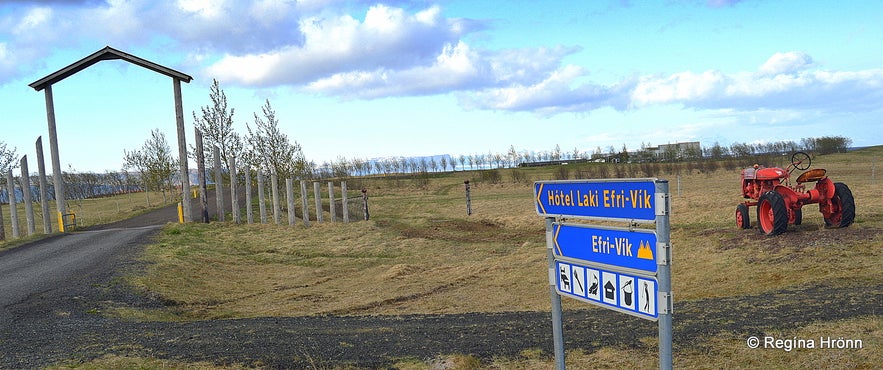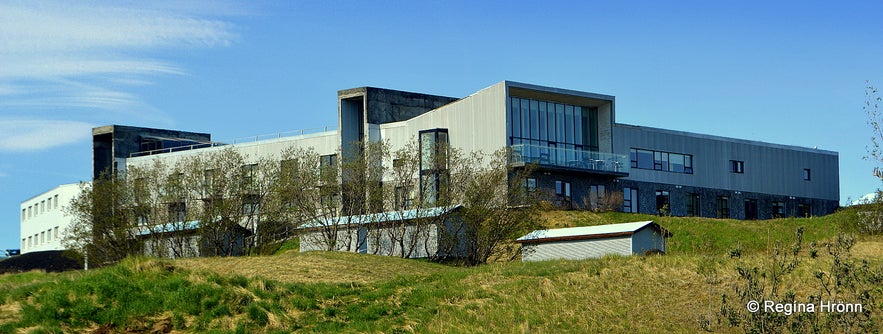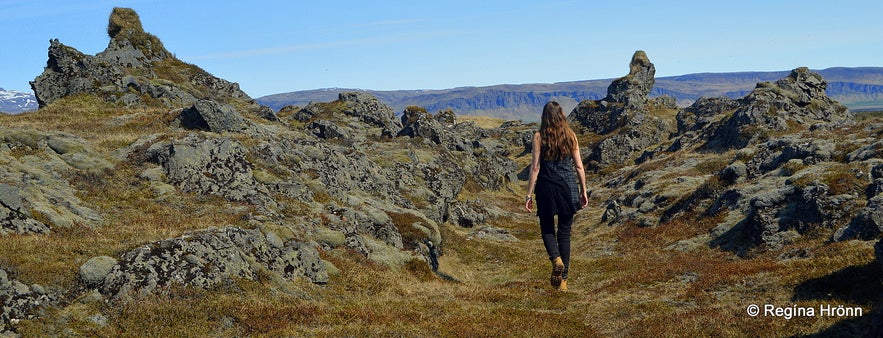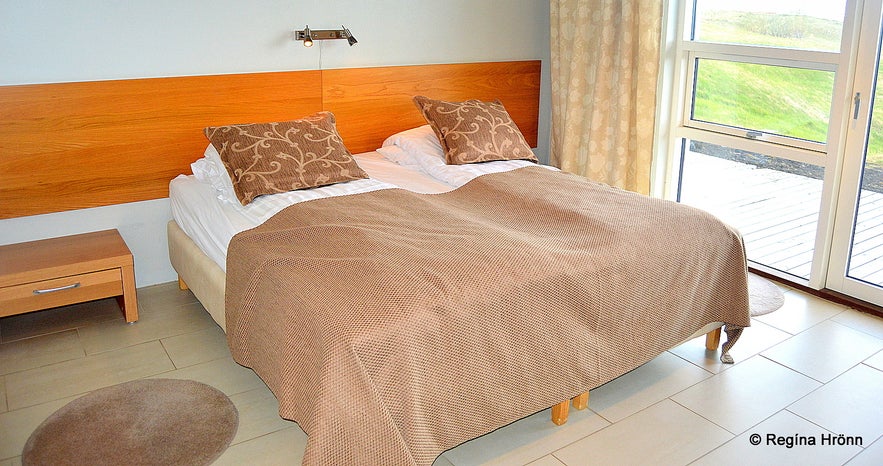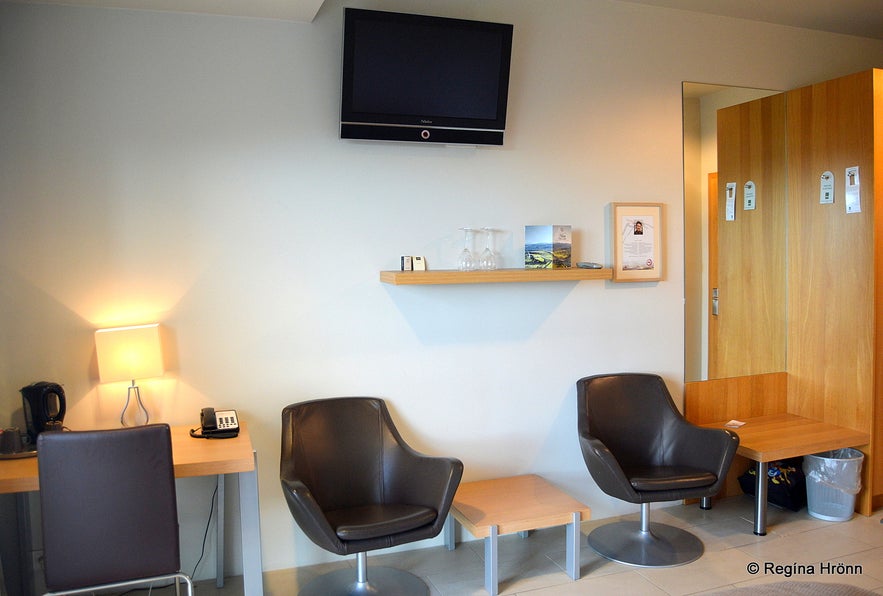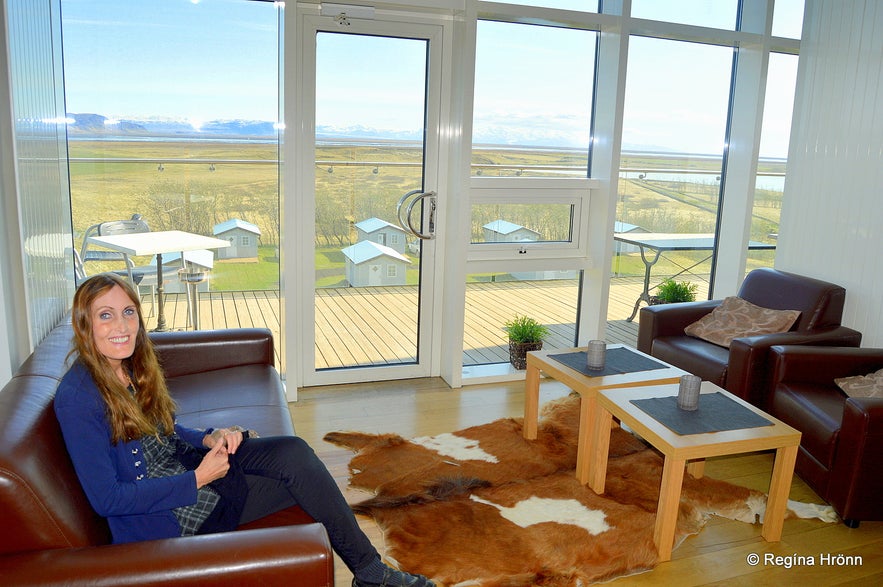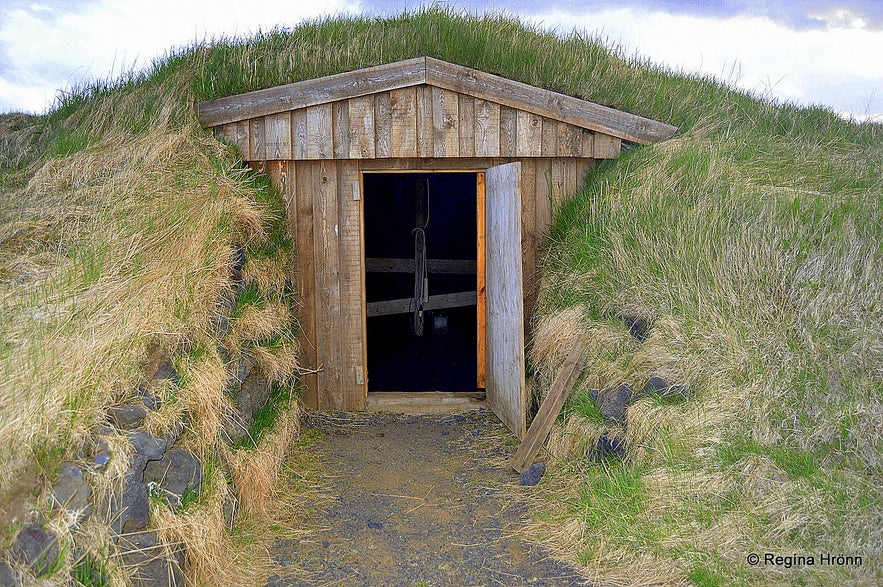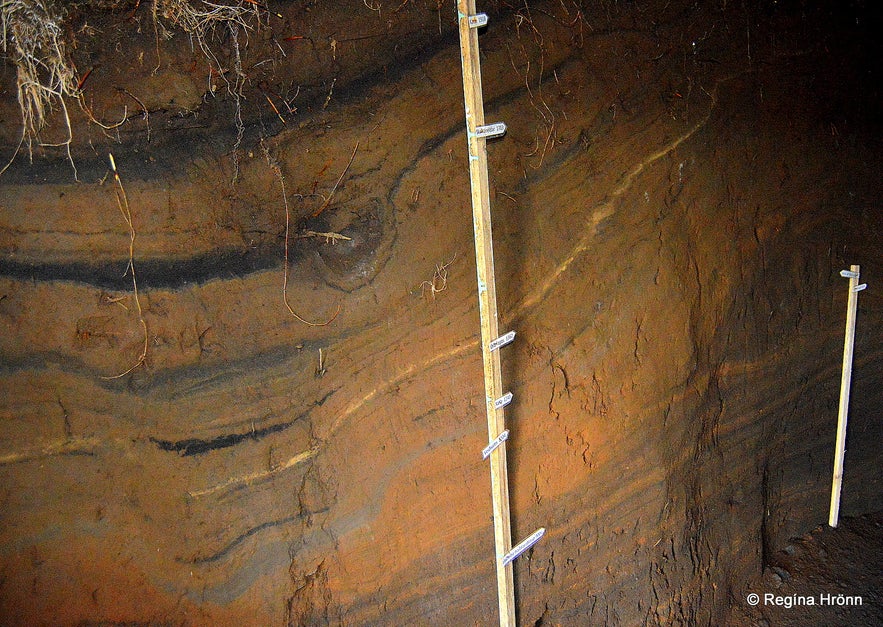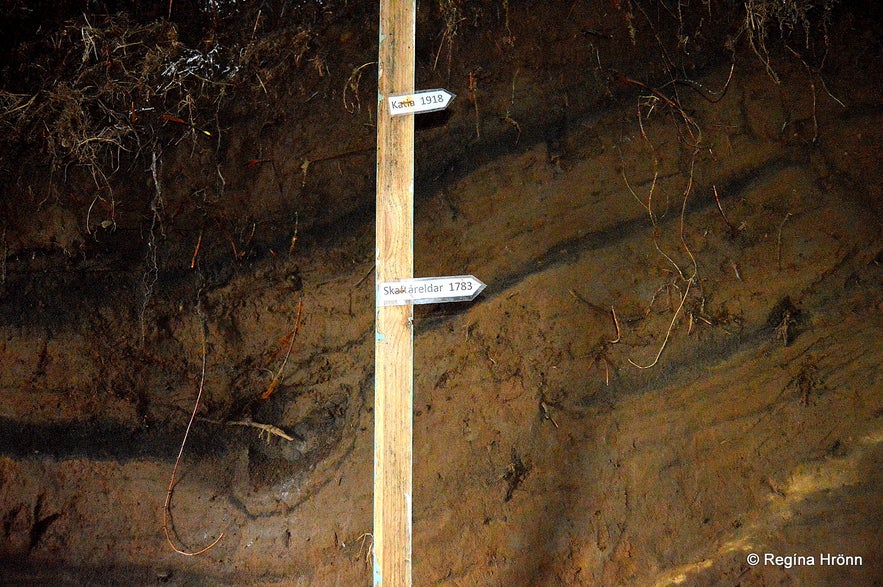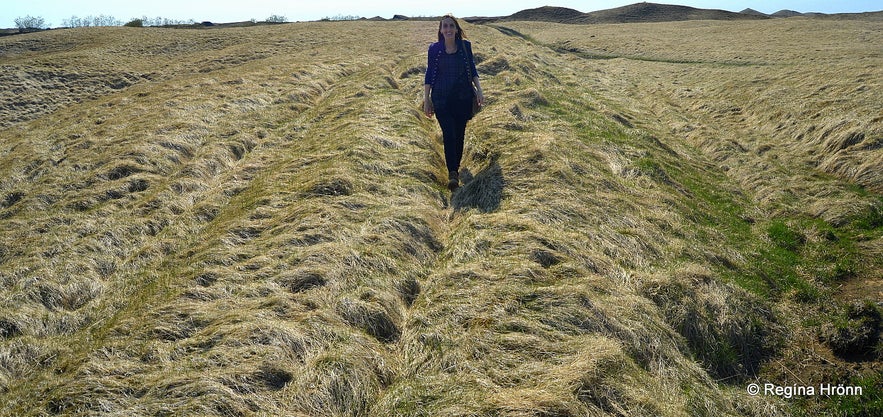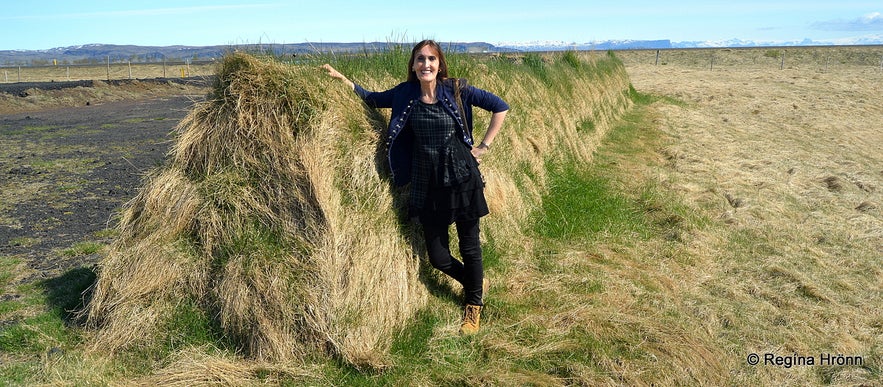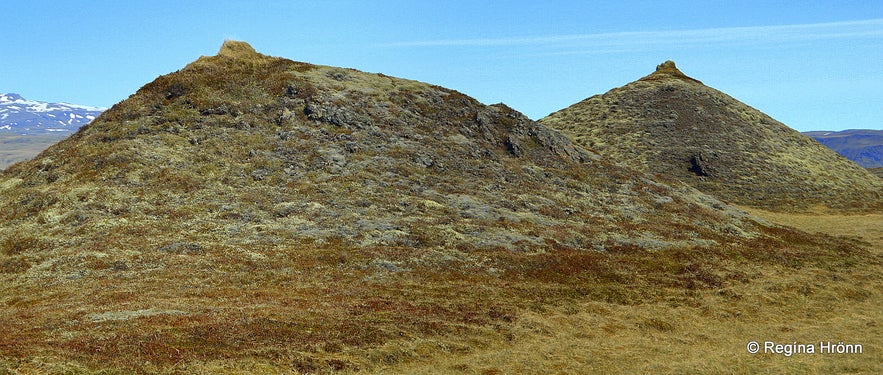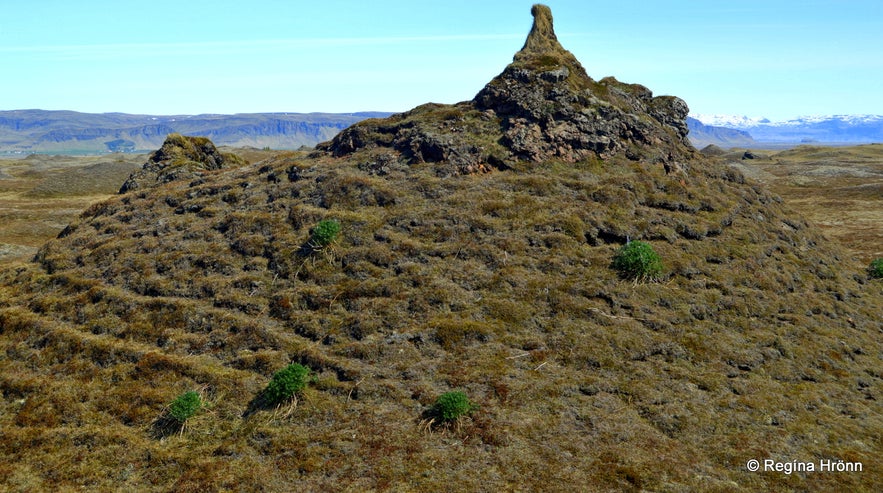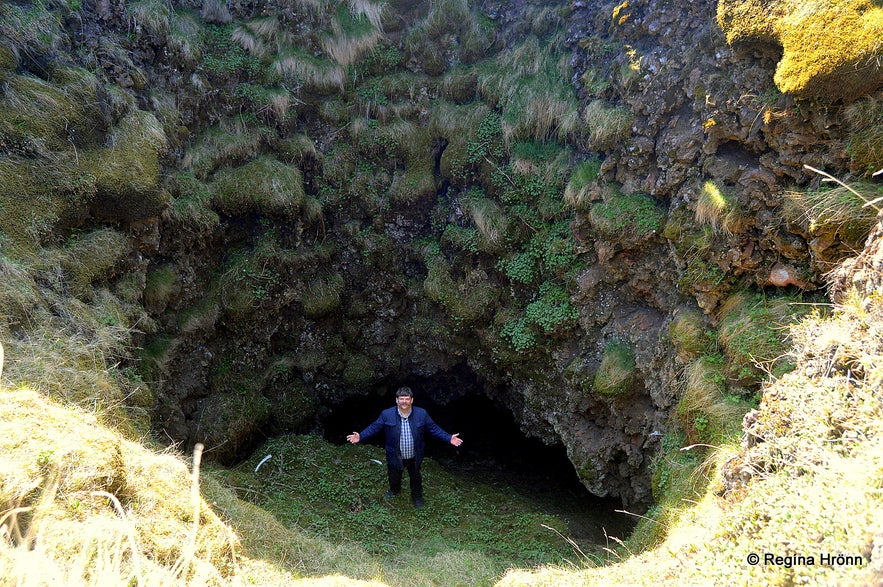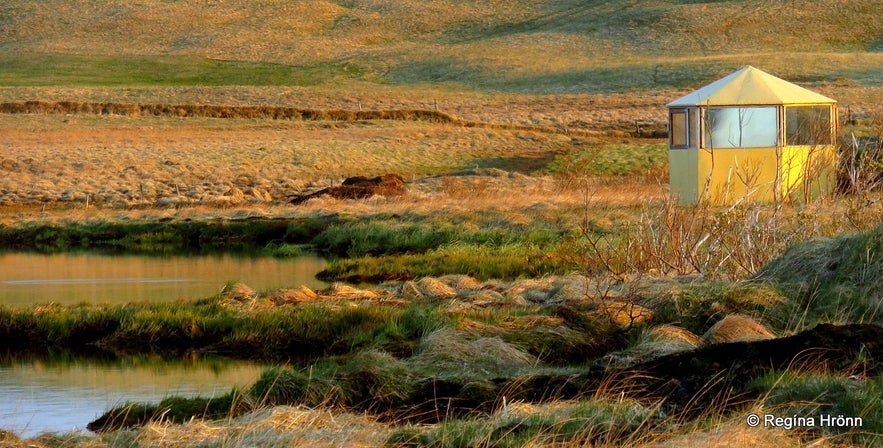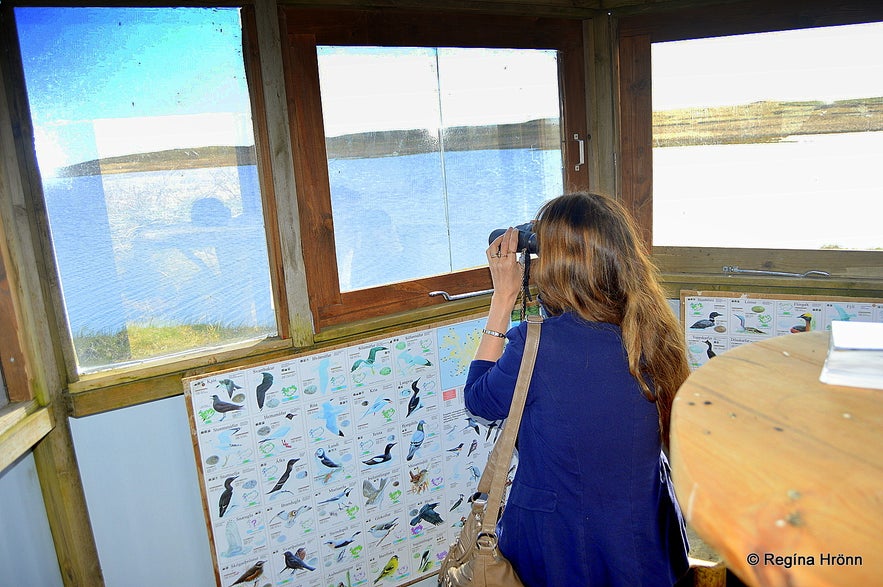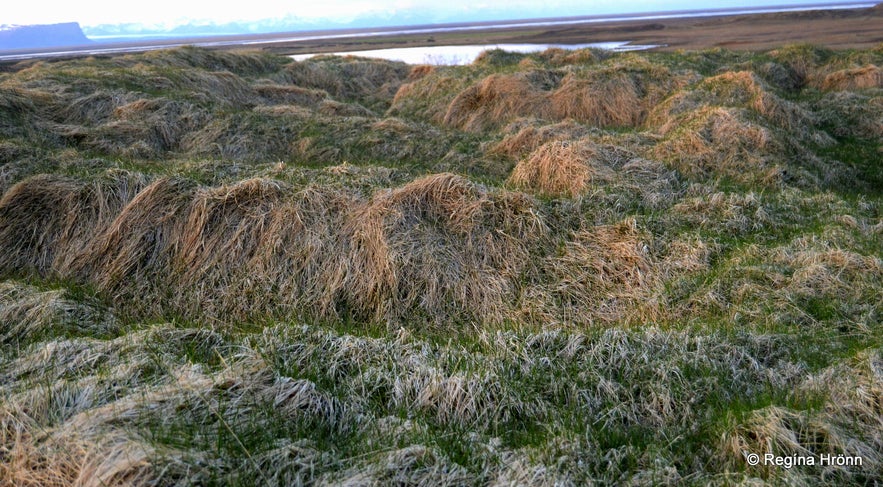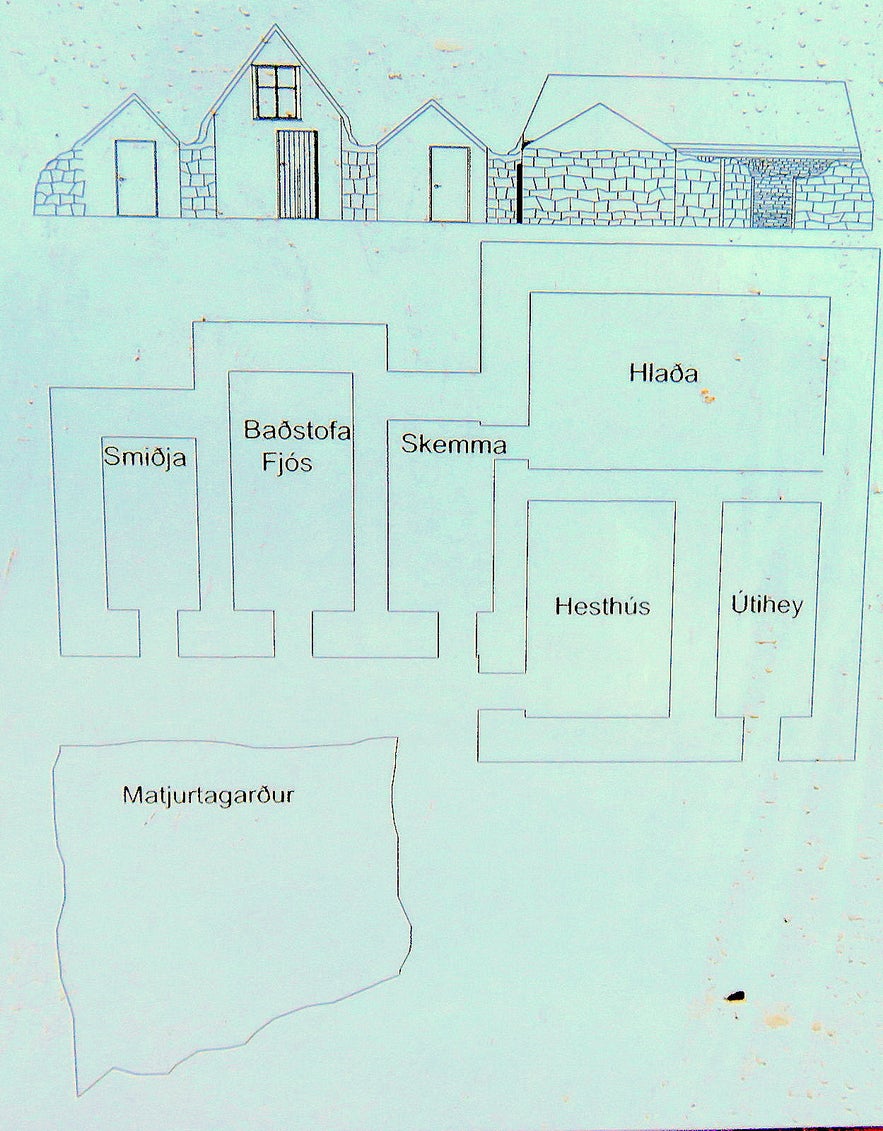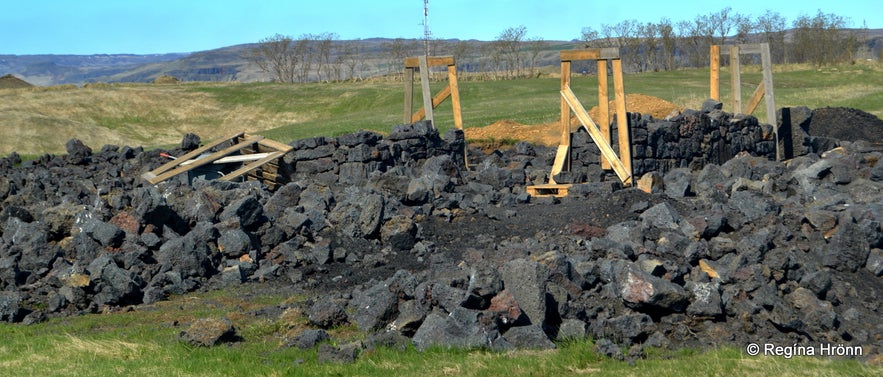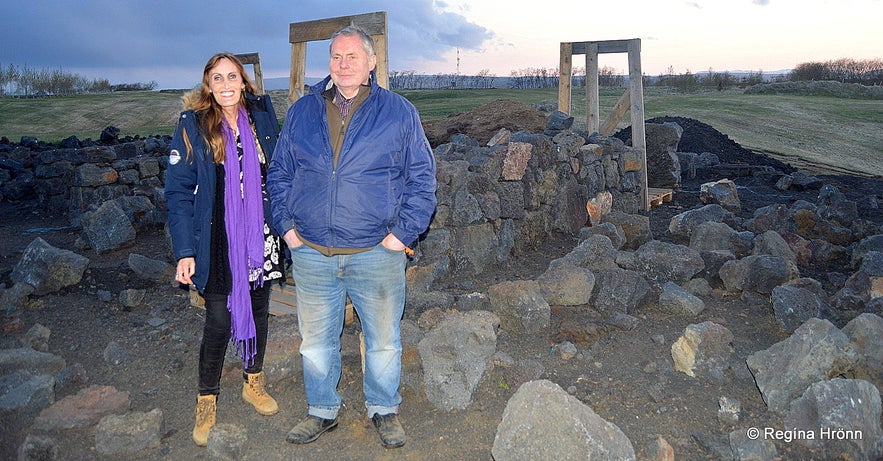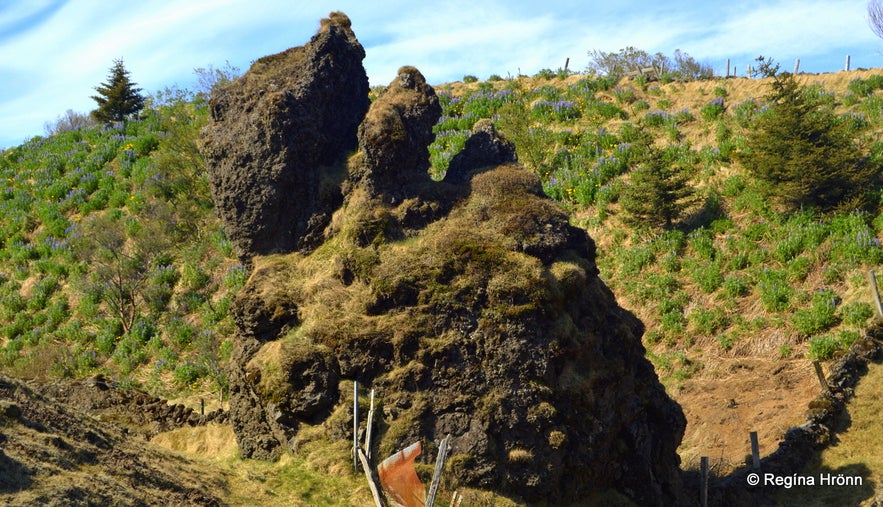
Hotel Laki at Efri-Vík and its Amazing Surroundings in South-Iceland

I stayed at the beautiful Hotel Laki at Efri-Vík recently, when I went to explore an area of Iceland called Landbrot. I had heard about interesting sights in this area in a TV-program back in 2013 and I so wanted to explore this part of South-Iceland.
To reach this area and Hotel Laki one has to get off ring-road 1 just before entering Kirkjubæjarklaustur village, which is a popular stop in beautiful surroundings.
After driving for 5 km this big hotel appeared. This was my first time in this area and I was amazed to see such a big and modern hotel here.
Hotel Laki Efri-Vík farm
Hotel Laki is a family-run hotel, run by Hörður Davíðsson and his wife Salome Ragnarsdóttir together with their daughter Eva Björk Harðardóttir and her husband Þorsteinn Kristinsson. They have been living on the farm at Efri-Vík since 1968. They started out as farmers, but in 1973 they started a small-scale travel service.
They live next to the hotel, which they started building in 2005. Seeing that it is family-owned I had not expected such a big hotel. It has got 64 rooms plus 15 cottages behind the hotel.
The hotel is named after Lakagígar, which is a row of craters some 40 km away from the hotel. At Lakagígar the biggest natural disasters in the known history of Iceland took place back in 1783, called the Skaftáreldar eruption.
Hotel Laki
Hörður was nice enough to give me a guided tour around his land.
I was so amazed at how much there is to see here, there is even an Elf City and Elf Church, which I had not known about. And those of you who read my blog know that I am always looking for new elf locations to visit, so this was a special treat for me.
I fell in love with the Elf City and Elf Church and wrote a special travel-blog about them, where you can read about this very interesting elf spot with several elf stories and loads of photos.
The amazing Elf City and Elf Church by Hotel Laki in South-Iceland
The Elf City
Hörður is a very knowledgeable man and I have utter respect for people of his caliber. He told us so many stories and showed us the farm ruins from Skaftáreldar in 1783, the turf house they are building, the Bunker of ash layers, and the remains of the 11th-century wall Bjarnagarður - and he told us about all the pseudocraters in this area, called Landbrotshólar pseudocraters.
You can get a map at the reception of Hotel Laki and take the so-called educational path, which will lead you to all of the above-mentioned sights in the vicinity of the hotel. I have written about all of these sights in detail in this travel-blog as I found them all to be very interesting.
Our room on our first visit to Hotel Laki
Our room was spacious and beautiful, the bed was comfy and there was a flat-screen TV. I felt so pampered. We had a beautiful view of the meadows, mountains, and cottages and I was extremely happy with my stay there.
I have stayed in all kinds of hotels, guesthouses, hostels, and in tents in camping areas all around Iceland and I would say that Hotel Laki is in the top 5 places of all of the places I have visited.
Kudos to this family for a job well done! And kudos to them for offering our nurses and doctors a free stay during Covid :)
Our room
There is a lovely sitting area by the restaurant where you can sit outside on a veranda with the most beautiful view. Hotel Laki is located between two glaciers, where you can see Öræfajökull glacier to the east and the dreaded volcano Katla in Mýrdalsjökull to the west.
I didn't dine at the restaurant as I was outside exploring the area and I only have coffee for breakfast, but my husband had breakfast in the morning at the restaurant and said it was good. And he loves his food ;)
At Hotel Laki
You can go up to the roof of Hotel Laki where there is a beautiful view and a glasshouse, from which one can watch the Northern Lights on winter nights. It must be wonderful sitting there in the heated glasshouse with a blanket and a hot drink watching the Northern Lights.
I wished I had such a glasshouse in my home in Reykjavík, as I often watch the Northern Lights while freezing on my balcony ;)
The Bunker of Ash Layers
Öskulagabyrgið - the Bunker of Ash Layers
Hörður, the owner of the hotel and the land, has erected a Bunker of Ash Layers (öskulagabyrgi) by the road opposite his hotel. He showed it to me and I must say that it is extremely interesting visiting it. I have never seen ash layers before apart from inside the ice cave tunnel in Langjökull glacier.
It is amazing being able to see layers of ash from different volcanic eruptions in this area - and there have been several massive eruptions here.
Öskulagabyrgið - the Bunker of Ash Layers
I was amazed and I think a visit to the Bunker of ash layers has to be a must-visit for geologists and everybody interested in geology. You can read the geological history of Iceland on the walls of the bunker in sedimentary strata, quite extraordinary!
Just imagine how many volcanic eruptions there have been here, which have coated this area with layers of ash! And here you can see like a CAT scan of these different volcanic eruptions from way back to the Settlement of Iceland.
You will be able to see ash layers from disastrous flooding from before year 900, from the volcanic eruption in Veiðivötn in 1204, from the volcanic eruption in Katla in 1240, from the Öræfagos eruption in 1362, from Skaftáreldar eruption in 1783, and from Katla in 1918.
Öskulagabyrgið - the Bunker of Ash Layers
Hörður is digging a deeper hole where he says there are layers of 5-6 meters below, which seem to have come from a catastrophic flood from one massive volcanic eruption. This eruption might have resulted in the formation of this area called Landbrot.
I just looked down into the hole but will come back for a visit, when Hörður will have finished this very interesting project.
Remains of the 11th Century Bjarnargarður Wall
Remains of the 11th Century Bjarnargarður Wall
By the Bunker of ash layers and inside it as well one can find the remains of the old wall Bjarnagarður, which is one of the biggest preserved man-made structures from the olden times, it dates back to the 11th century!
In the photo above I am walking inside the collapsed wall. This 11th-century wall proves that there has been traditional farming in this area since the Settlement of Iceland.
The bunker has been dug through the remains of the wall Bjarnagarður, and inside the bunker, one can see what this old wall was made of.
Remains of the 11th Century Bjarnargarður Wall
The inside of Bjarnagarður wall can be seen in the Bunker of ash layers as you can see in my photo above. "Áfok að Bjarnagarði" to the left means subaerial deposition to Bjarnagarður wall and to the right one can see the wall itself.
Bjarnagarður was an 8-10 km long wall which was most likely erected to keep sheep inside or outside for that matter, so it is probably sheep related ;) They were erected to legally protect the meadows and pastures. Most parts of it have collapsed through the centuries and through all these volcanic eruptions, but you can see it vividly in some places although it has collapsed.
Replica of the remains of the 11th Century Bjarnargarður Wall - it is just a little lower than I
Hörður has erected a 50 m long replica of Bjarnagarður wall in front of the Bunker of ash layers on his land in Efri-Vík, so we can see how high and massive the wall must have been before it collapsed. Hörður has named this 50 m long wall "Mórallinn" or the Guilty Conscience.
He has bequeathed 3 metres of the wall to the Road Administration of Iceland (Vegagerðin) and 5 metres of the wall to the Cultural Heritage Agency of Iceland (Minjastofnun) - as neither of these establishments has done anything to protect or inform the inhabitants in this area of Bjarnagarður wall - so they should have a guilty conscience in his opinion ;) I hope this has been corrected.
Replica of the remains of the 11th Century Bjarnargarður Wall
Written in Jónsbók, which is an Icelandic law book from 1281, is the following sentence: "Hver maður skal löggarð gera um töðuvöll sinn" - meaning that everybody should build a wall around their hayfield - and this could be the reason why this massive wall was built.
Landbrotshólar pseudocraters
Landbrotshólar pseudocraters
Landbrotshólar pseudocraters is an interesting area to visit. It is the largest area of pseudocraters in Iceland, covering an area of around 50 sq.km! The pseudocraters, or rootless cones, form when extremely hot lava flows into wetlands.
When such hot lava comes into contact with water the water boils and explosions from the hot steam take place.
Landbrotshólar pseudocraters
It is not known exactly when these pseudocraters formed, but most likely they were formed during the massive volcanic eruption in Eldgjá back in the year 934-938. Eldgjá lies parallel with Lakagígar craters.
The pseudocraters are hollow inside and you can even find some open pseudocraters and have a peek inside, which is really interesting.
I have read that some of the hollow craters were used as a shelter for sheep and I found one hollow pseudocrater which is obviously used as a refuse dump. We found one big pseudocrater which was hollow inside and in the photo above you can see my husband, who climbed down into the crater.
My husband inside one of the Landbrotshólar pseudocraters
There are thousands of pseudocraters in this area, some of which look like cones and pyramids and others are round and look like bosoms.
See also: the unique Phenomenon Pseudocraters in Iceland
Hólasport at Efri-Vík by Hotel Laki offers ATV/Quad biking tours at Landbrotshólar pseudocraters and to other interesting areas in the vicinity.
The Bird-Watching Hut at Efri-Vík
The Bird-Watching Hut at Efri-Vík
Behind Hotel Laki there is a beautiful little lake called Lake Víkurflóð, where it is possible to catch brown trout and Arctic char. You can buy angling licenses at the hotel reception.
By the lake, you will notice a cute yellow hut, which is a bird-watching hut as there are myriad birds on the lake. Binoculars are provided and on the walls are posters with both birds and fish species and books on birds.
Bird watching at The Bird-Watching Hut at Efri-Vík
I was told that swans moved into the hut soon after the owners built it and lived there for some years :) I would have loved to see that.
Farm Ruins from Skaftáreldar Eruption in 1783
Farm Ruins from Skaftáreldar Eruption in 1783
On the land of Efri-Vík, there are visible ruins from an old farm which was abandoned in the disastrous Skaftáreldar volcanic eruption in 1783, which took place at Lakagígar some 40 km away from Efri-Vík.
Some 29 farms in this area were abandoned during this massive volcanic eruption. The gaseous plumes killed the livestock which caused famine on top of everything. 20% of the Icelandic population (some 10,000 people) lost their lives during these disastrous times.
Skaftáreldar caused massive destruction - it is the biggest lava flow on earth from a single eruption in historic times - and the gaseous plumes caused the following winter to be cold all over Europe.
It is difficult to take photos of such ruins even though they are clearly visible to the naked eye. You can see the ruins of a foundry, a sitting room (baðstofa), a horticultural garden, a storehouse, a barn, and a stable.
The ruins of the old turf farm are located on the meadow by Hotel Laki and they are clearly marked on the map of the surrounding area, which I got at the hotel reception.
The turf house
The turf house at Efri-Vík in 2016
In the photo below you will see the owner of the land and Hotel Laki, Hörður, with me by the turf house he and his family is building.
They don't want this old way of building turf houses to be forgotten and went on a course in turf house making, so they could build a turf house on their own land to show this old Icelandic way of building houses to their guests.
With Hörður by the turf house in 2016
I think this is a brilliant idea. I myself am looking into attending a course in turf house building in Skagafjörður. The turf house project at Hotel Lakis is on hold now (2019), but I hope this turf house will be erected one day.
I stayed for another night at Hotel Laki in September 2020 with my mother as I wanted to show her this wonderful place and by then the turf house looked like this:
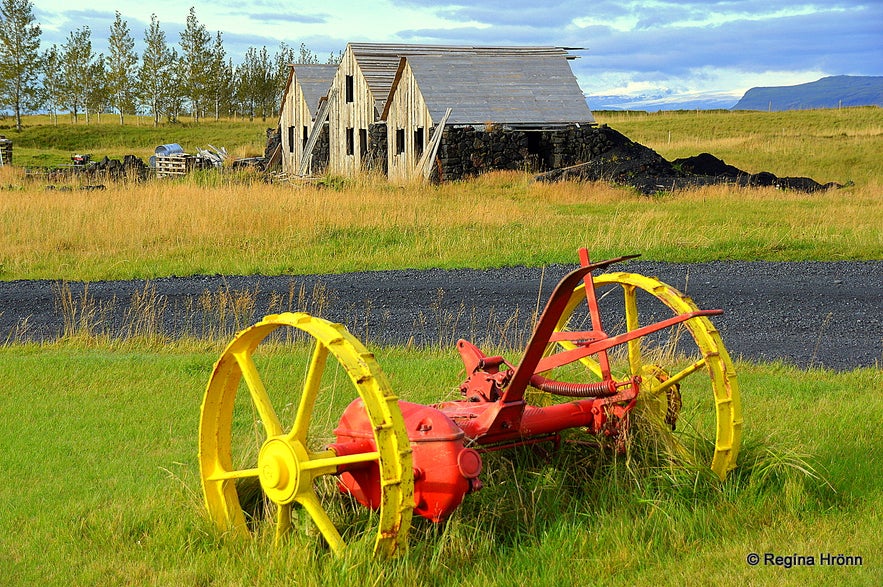
The turf house in September 2020
I am a big fan of turf houses and have visited and written about almost all of the remaining turf houses and turf churches in Iceland.
I had such a lovely stay here and the next day I drove down to the end of Landbrot, as it were, to explore this area further.
I "found" a peculiar pillar of rock (lava) on the land of Þykkvibær. It reminded me of Lóndrangar cliffs on the Snæfellsnes peninsula. I have seen no information on this lava rock, but I am positive that it is elf-related. If anybody reading my travel-blog can give me information on this rock then I would be very grateful :)
A strange rock formation
Hotel Laki and the Elf City are located 262 km away from Reykjavík and only 5 km away from Kirkjubæjarklaustur village. Turn from ring road 1 onto road 204.
To visit this area you can rent a car in Reykjavík and drive to it and spend the night at the hotel for the night. There are myriad of interesting sights to see on the way from Reykjavík.
On the way, you will find many interesting sights such as the beautiful waterfalls of South-Iceland, Kirkjubæjarklaustur, and Foss at Síða & Dverghamrar to name just a few of the interesting sights on the south coast of Iceland.
See also:
The Beautiful Elf City and Elf Church by Hotel Laki in South-Iceland
Have a lovely time in South Iceland :)
Andere interessante blogs
Noorderlicht in Ijsland
Als je nog nooit de kans hebt gehad om een ‘noorderlicht-show’ te zien en het één van je dromen is, dan is een reis naar Ijsland in de winter een echte aanrader. Het is geen garantie maar de kans beLees verderReizen naar IJsland per boot
Ik ben eind mei 2017 naar IJsland geemigreerd en ben met mijn eigen auto en de boot gegaan. Wat mij opviel is dat hierover heel erg weinig te vinden is qua reizigers ervaringen. Vandaar dat ik heb besLees verderGeitenboerderij Háafell
Ik geef het eerlijk toe, ik wist tot 2 jaar geleden ook niet van het bestaan van de IJslandse geit af. Totdat ik hoorde dat er 200 geiten op de nominatie stonden om geslacht te worden omdat in IJslandLees verder

Download het grootste reisagentschap van IJsland op je telefoon en beheer je hele reis op één plek
Scan deze QR-code met de camera van je telefoon en klik op de link om het grootste reisagentschap van IJsland in je zak te stoppen. Voeg je telefoonnummer of e-mailadres toe om een sms of e-mail te ontvangen met de downloadlink.

